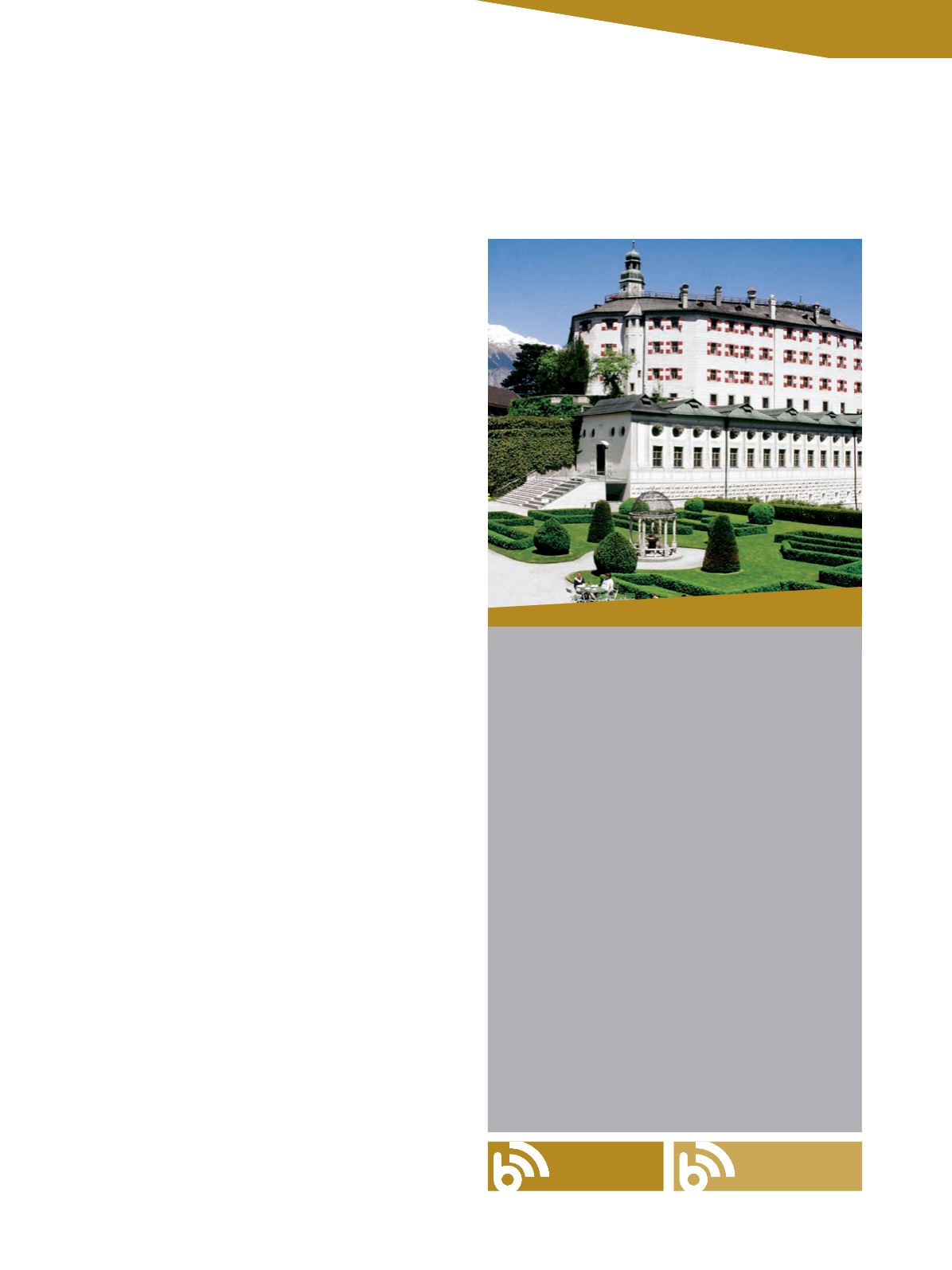

WELCOME
||
121
FERDINAND II. – 450 JAHRE TIROLER LANDESFÜRST
15. Juni 2017 bis 8. Oktober 2017, täglich von 10–17 Uhr
In der Ausstellung werden besondere Kostbarkeiten aus den
Beständen des Kunsthistorischen Museums, von nationalen
und internationalen Museen, Kunstsammlungen und Bibliothe-
ken sowie aus Privatbesitz gezeigt. Das Ausstellungskonzept
wurde von Schloss Ambras Innsbruck in Kooperation mit der
Tschechischen Nationalgalerie und dem Institut für Kunstge-
schichte der Akademie der Wissenschaften der Tschechischen
Republik erarbeitet.
FERDINAND II. – 450 JAHRE TIROLER LANDESFÜRST
15 June to 8 October 2017, open daily from 10 a.m. to 5 p.m.
The exhibition presents special treasures from the collections of
the Kunsthistorisches Museum Vienna, from other Austrian and
international museums, art collections and libraries as well as
from private collections. The exhibition concept was developed
by Schloss Ambras Innsbruck in collaboration with the Czech
National Gallery and the Institute of Art History at the Czech
Academy of Sciences.
Schloss Ambras Innsbruck
Schlossstraße 20, A-6020 Innsbruck,
info@schlossambras-innsbruck.at,t
+43 1 525 244802
www.schlossambras-innsbruck.atE
s wird das Innsbrucker Kulturereignis dieses Jahres: Eine
hochkarätig bestückte Großausstellung auf Schoss Ambras
widmet sich Erzherzog Ferdinand II., der vor 450 Jahren, am
17. Jänner 1567, als künftiger Tiroler Landesfürst seinen feierlichen
Einzug in Innsbruck hielt.
Der Habsburger (1529–1595), der einer der bedeutendsten euro-
päischen Herrscherdynastien entstammte, wurde von seinem Vater,
Kaiser Ferdinand I., mit der Funktion des Statthalters im Königreich
Böhmen betraut und residierte ab 1547 in Prag. In Innsbruck lenkte
er schließlich 30 Jahre die Geschicke der Grafschaft Tirol und der ös-
terreichischen Vorlande.
Ferdinand II. war ein überaus gebildeter Mensch, er sprach meh-
rere Fremdsprachen fließend und entwickelte an den Orten seines
politischen Wirkens eine ausgeprägte höfische Repräsentationskul-
tur. Als humanistisch gebildeter Fürst trug er wesentlich zur Verbrei-
tung der Renaissance in Mitteleuropa bei. Die sichtbarsten Spuren
hinterließ Ferdinand II. auf Schloss Ambras mit dem einzigartigen
Renaissance-Ensemble und den Rüstkammern sowie der Kunst-
und Wunderkammer. Sein Sammlungskonzept war bahnbrechend
für die Entwicklung des Museumswesens. Für seine bereits damals
weithin beruhmten Sammlungen ließ der humanistisch gebildete
Fürst ein eigenes Museumsgebäude errichten, das bis heute am ur-
sprünglichen Ort erhalten geblieben ist. Schloss Ambras Innsbruck
ist damit das älteste Museum der Welt und ein unvergleichliches
Kulturdenkmal der Renaissance.
||
I
t will be the cultural event of the year in Innsbruck: a sumptuous-
ly furnished large exhibition at Schloss Ambras dealing with Arch-
duke Ferdinand II, who made his solemn entrance in Innsbruck as
future Tyrolean prince 450 years ago, on 17 January 1567.
The Habsburg (1529–1595), who hailed from one of Europe‘s most
powerful monastic dynasties, was entrusted with the function of Gov-
ernor in the Kingdom of Bohemia by his father Ferdinand I and resid-
ed in Prague from 1547. In Innsbruck, he finally controlled the fate of
the County of Tyrol and the Austrian forelands for thirty years.
Ferdinand II was a highly educated man, he spoke several lan-
guages fluently, and in the locations of his political activities de-
veloped a distinctive culture of courtly representation. As a prince
adhering to the principles of humanism he made an important con-
tribution to the spread of the Renaissance in Central Europe. The
most visible traces Ferdinand II left at Schloss Ambras are the unique
architectural ensemble as well as the Rüstkammern (armories) and
the Kunst- und Wunderkammer (chamber of art and curiosities). With
his concept as a collector he was a pioneer in the history of muse-
ums. For his collections, famous even in his lifetime, the humanist
prince had a special museum building erected which has remained
intact in its original site until this day. Schloss Ambras Innsbruck
thus is the oldest museum in the world and an incomparable cultural
monument to the Renaissance.
||
bit.ly/2nz4yxz bit.ly/2nyS60D















